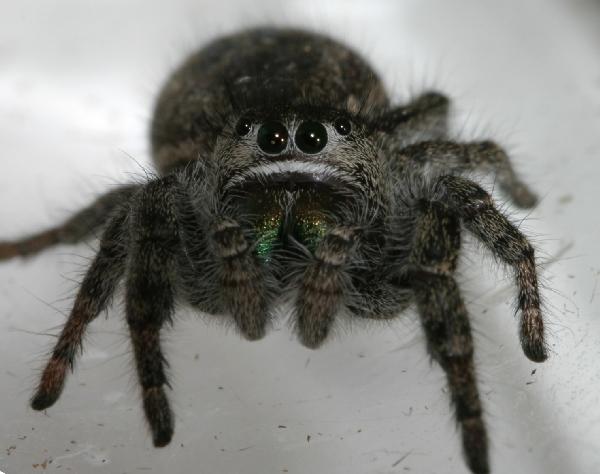Black Jumping Spider with Green Mouthparts
And for Leap Day, here’s a little something that leaps!
Sandy found this great big jumping spider in the house on October 13, 2011. It was about a centimeter long, which is unusually large for the local jumping spiders.
Jumping spiders commonly prey on fruit flies, so Sandy put some of her wingless fruit flies into the jar for it to eat.
The abdomen was dark, nearly black, and had eight white spots running down it.
Overall, it looked very similar to this immature jumping spider that I photographed back in May 2010. It even has the same little tufts of hair on the head, and the white “moustache” under the eyes.
The chelicerae (mouthparts) are iridescent green, which is characteristic of adult jumping spiders in the genus Phidippus[1]. These also tend to be particularly large jumping spiders.
The spider came out kind of dark, unfortunately. Mainly because I didn’t pick a good background, I think: dark spider on a white background just ends up looking dark. It probably would have worked better with a less harsh background. Anyway, looking over BugGuide and Wikipedia I’m not finding a really good match for this one. Probably because, according to Wikipedia, there are 60 species in the Phiddipus genus, and BugGuide looks like it has pictures for less than half of them.
———
[1] Browsing around, I’ve been seeing some hints that it is the male Phidippus that have the iridescent mouthparts, but I’m not sure if that is a universal trait of all the spiders in the genus, or only some. Which means that I’m still not sure whether this one is male or female.
Comments are closed.






How beautiful! Green mouthparts – who’d’a thunk it?!?
Hey I found this in my car. Can it bite and is it poisonous? Also what is it? I am extremely scared of spiders but I have to admit he is buetiful
They can (but usually won’t) bite. My daughter says that one bit her once, and that it was on the order of a sting from one of the smaller bees. The venom is nothing special, so even if they bite it isn’t a big deal.